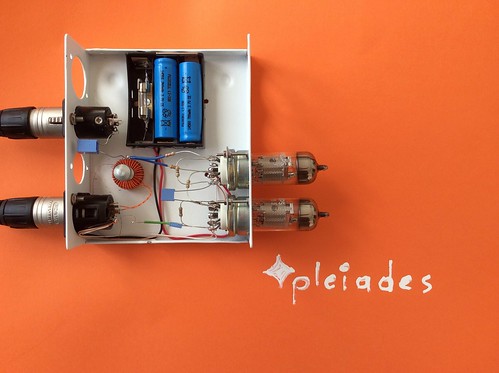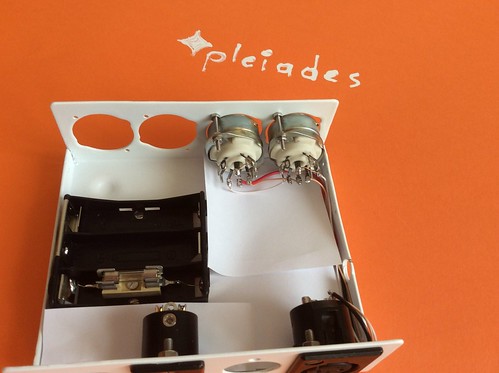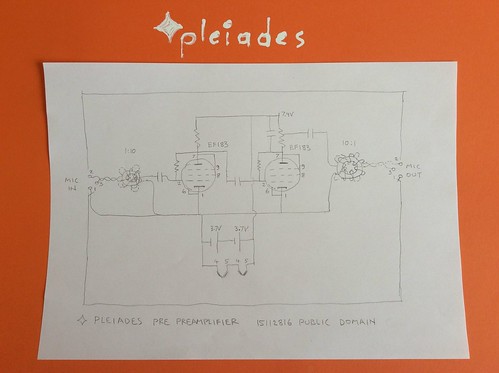This started at about 1999.
The microphone drives the primary of the input transformer. The secondary is connected to the grids of a balanced configuration of UCC85.
The anodes are connected to the primary of the output transformer. The secondary is the balanced output of the very quiet pre preamplifier.
The cathodes are connected together with one side of a 270 ohms resistor , the other side to ground.
This was a stereo 2 channel amp so two UCC85 were used. Heaters in series were driven by 4x12V lead acid batteries in a separate sealed cast aluminum box.
So 48V were also connected to the center tap of the output transformers.
48V is also convenient since if connected to the center tap of the primary of the input transformer, phantom power is ready.
The amplifier was built in a cast aluminum box from Canford. Tubes on top as well as as the 4 Sowter transformers. 1:7 was used for input and 1:1 for output either 10K:10K or 600 to 600.
The amp was used with AKG 12A Nuvistor microphones as Blumlein Pair.
The mics were near the drums. The mics were on cardiod looking at the organ past one step so that some direct sound could be picked up from the drums. All instruments including drums, self amplified guitar, bass guitar and PCL86 amplified organ with Pleiades Leslie hung from the ceiling so that the open back speaker could freely revolve sounded very nice. Out out of the amp was connected directly to the input of Philips CDR870. Some more gain could have been useful as the amp could not fully modulate the recorder. This was useful as there was no clipping involved in the jam no matter what, or was this the compression effect of tubes with grid bias self adjusted when peaks were trying to charge grids negatively due to diode rectification effect?
The interesting thing about this amp that there is no return circuit for grids.. By listening and watching now at VU meters it seems the amplifier was self compressing at loud signals since the grids were free to keep the potential convenient for them.
There was also an 1K resistor in series with battery plate supply inside the amp,
Now the amp has been changed to 2 ECC82 parallel heaters and O ohms cathode resistor, and 12V battery supply. Interesting is that the intensity of light in the room adjusts gain of the amp possibly due to photoelectric effect of grids?
The amp may be reconverted to UCC85.
The microphone drives the primary of the input transformer. The secondary is connected to the grids of a balanced configuration of UCC85.
The anodes are connected to the primary of the output transformer. The secondary is the balanced output of the very quiet pre preamplifier.
The cathodes are connected together with one side of a 270 ohms resistor , the other side to ground.
This was a stereo 2 channel amp so two UCC85 were used. Heaters in series were driven by 4x12V lead acid batteries in a separate sealed cast aluminum box.
So 48V were also connected to the center tap of the output transformers.
48V is also convenient since if connected to the center tap of the primary of the input transformer, phantom power is ready.
The amplifier was built in a cast aluminum box from Canford. Tubes on top as well as as the 4 Sowter transformers. 1:7 was used for input and 1:1 for output either 10K:10K or 600 to 600.
The amp was used with AKG 12A Nuvistor microphones as Blumlein Pair.
The mics were near the drums. The mics were on cardiod looking at the organ past one step so that some direct sound could be picked up from the drums. All instruments including drums, self amplified guitar, bass guitar and PCL86 amplified organ with Pleiades Leslie hung from the ceiling so that the open back speaker could freely revolve sounded very nice. Out out of the amp was connected directly to the input of Philips CDR870. Some more gain could have been useful as the amp could not fully modulate the recorder. This was useful as there was no clipping involved in the jam no matter what, or was this the compression effect of tubes with grid bias self adjusted when peaks were trying to charge grids negatively due to diode rectification effect?
The interesting thing about this amp that there is no return circuit for grids.. By listening and watching now at VU meters it seems the amplifier was self compressing at loud signals since the grids were free to keep the potential convenient for them.
There was also an 1K resistor in series with battery plate supply inside the amp,
Now the amp has been changed to 2 ECC82 parallel heaters and O ohms cathode resistor, and 12V battery supply. Interesting is that the intensity of light in the room adjusts gain of the amp possibly due to photoelectric effect of grids?
The amp may be reconverted to UCC85.


